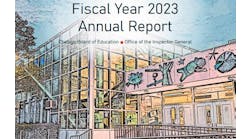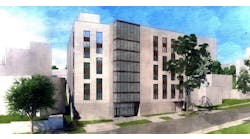Teachers throughout the country complain of unrelenting pressures to adapt their methods to new technologies. Who, they ask, is reaching out to us and making sure that distance learning serves the requirements of instruction? In this atmosphere, planners can take steps to make distance learning a viable teaching method that is reliable and advantageous for all.
The design of distance-learning classrooms can address these concerns and help utilize the latest in technology for schools and universities.
How they work
In a typical distance-learning classroom, the instructor speaks to students at a remote site by way of a camera placed in the rear of the room. Also at the back of the room are TV monitors that show the students at the remote site. The instructor can zoom in so that interaction with students can occur "face-to-face." A camera at the podium replaces the blackboard or whiteboard. Audiovisual materials are digitized and sent to projectors and monitors at both sites.
The instructor is perceived as speaking directly to the students at the remote site. In turn, students can respond directly to the instructor. Monitors display the instructor's writing, as well as audiovisual materials such as slides and overheads. Students also can see their counterparts at the other site. In this manner, each set of students sees what's going on in the other classroom.
Nuts and bolts
Distance-learning classrooms have specific requirements to make them effective:
-Cabling runs and raceways. Distance-learning classrooms need power, data and video, and cabling runs along all four walls and into the ceiling. These lines also will go to the podium. If the floor is concrete, a trench about two inches deep is necessary. There is virtually no way to avoid this, so be sure to include the cost of the trench in your estimate. Cabling runs into the control booth, and then will need to run back to a central control and broadcast site.
-Control booth. Distance-learning classrooms require a control booth at each site. An 80-square-foot room should be constructed to house control equipment. If space is not available, it is possible to set up the control booth inside the classroom.
-Microphones. These need to be multidirectional and supersensitive. As such, these devices are subject to disruption. Noise disruption is probably the biggest problem in designing distance-learning classrooms. Therefore, do not attach microphones to the desktops; install them in the ceiling.
-Acoustical treatment. This is essential. The walls in a distance-learning classroom require specialized acoustical fabric. However, conventional ceiling tiles and carpet are sufficient on the ceiling and the floor. Both have the sound-absorbency to do the job.
-Lighting upgrade. In the early 1990s, it seemed that distance-learning classrooms would need studio-lighting capability, but that turns out not to be the case. Classrooms do require zoned lighting, though.
-HVAC. With computers comes an additional cooling load. However, cooling is not the main challenge. HVAC noise from the air ducts, diffusers, fans and motors often throws the microphones off. Unfortunately, the noise that does the damage cannot always be heard at the broadcast site. Everything sounds fine there, but distortions are received and amplified, and sent to the remote site. Installing low-noise diffusers is an inexpensive way to prevent this disruption.
-Cameras. Each site will need three-one directed at the students, one for the instructor and one overhead camera for the writing pad.
-Video monitors. One example of monitor use is four to a room, 3 feet by 4 feet. However, a larger number of smaller ones can be used.
-Podium touch-control panel. Touch-control panels that put equipment controls at the instructors' fingertips are available.
-Staffing. Students are stationed at control booths at each site. Students do more than control the equipment, however. Often, they serve as facilitators for communication between faculty and students. By using student labor, schools can keep costs minimal.
-Transmission. A CODEC is used for transmission. T-1 high-speed lines are the typical transmission mode, and some universities also make use of ISDN transmission.
-Power. A distance-learning classroom requires 40 amps in the control booth and about 80 amps in the classrooms, depending on their size. Keep in mind that a power upgrade may be required to satisfy these needs.

